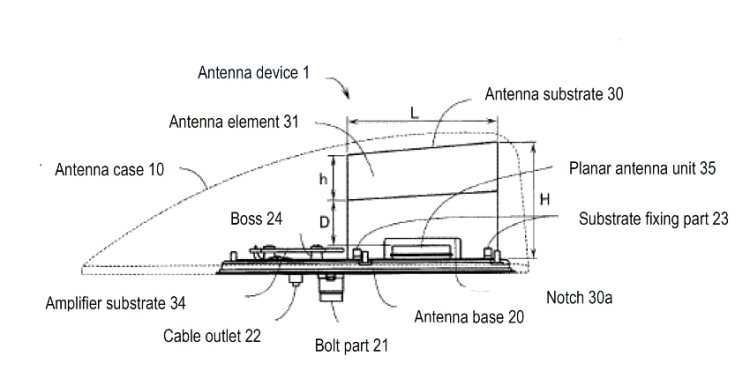2023.07.31 Patent
A case in which patent was determined to be invalid for violation of support requirements and no infringement was found established

1. Introduction
This newsletter introduces a case in which the Japanese IP high court determined in a patent infringement lawsuit (No. 2020 (Ne) 10039) that the patent should be invalidated for violation of the support requirements, and no infringement is established.
In the present case, the relationship between the scope of the invention recited in claims and the invention described in the Detailed Description of the Invention (embodiments) was examined in accordance with a basic judging method regarding the support requirements, and whether the support requirements are fulfilled was determined. We hope that this article will help you understand the support requirements in Japan.
2. Outline of Case
This is a case in which the court held regarding an invention titled “antenna device” that, since the invention recited in claims is not found to be the invention described in the Detailed Description of the Invention in the specification, and the invention is not found to be within the scope that a person skilled in the art can recognize that the problem can be solved by the description in the Detailed Description of the Invention or suggestion thereof or in view of the common general technical knowledge at the time of filing, the support requirements are not fulfilled, and thus the patent according to the claim concerned should be invalidated through a trial for patent invalidation. Therefore, the court held that the appellant may not exercise the patent right against the appellee, dismissing the appeal by upholding the judgment of in the prior instance which dismissed the claim of the appeal.
In the prior instance, the plaintiff (appellant), the patentee of the Japanese patent No. 5237617 (hereinafter referred to as “Present Patent”) demanded injunction and compensation for damages against the defendant (appellee) on the grounds that the defendant’s (appellee’s) product falls within the technical scope of the patented invention of the Present Patent.
3. Constituent Features of Present Patent
The invention according to Claim 1 of the Present Patent (hereinafter referred to as “Present Invention”) is as follows.
[Claim 1]
An antenna device comprising:
an antenna case protruding to a height of approximately 70 mm or less from a vehicle when mounted on the vehicle; and
an antenna unit accommodated in the antenna case, wherein
the antenna unit includes:
an antenna element having a planar shape with an upper edge following a shape of an internal space of the antenna case; and
an amplifier substrate having an amplifier for amplifying signals of FM broadcasting and AM broadcasting received by the antenna element,
a power supply point of the antenna element is connected to an input of the amplifier through an antenna coil located between the antenna element and the amplifier substrate in a height direction,
the antenna element and the antenna coil are connected to thereby resonate in an FM wave band,
the antenna element is used to receive an AM wave band, and
the signals of the FM broadcasting and the AM broadcasting are amplified by the amplifier connected through the antenna coil.

4. Points at Issue
In the present case, although there were many points at issue, the court held the decision, focusing on the points related to the support requirements.
Arguments of the appellee (defendant in the prior instance) and of the appellant (plaintiff in the prior instance) with regard to the support requirements are excerpted and shown below.
Please note that the underlines shown below are added by the editor of this article.
<Arguments of Appellee (Defendant in Prior Instance)>
The problem to be solved by the invention described in the Detailed Description of the Invention is that, in an antenna device including an antenna case having only a limited space, if a further antenna is incorporated in addition to an antenna element, the further incorporated antenna is affected by the existing antenna, and favorable electrical characteristics cannot be obtained ([0008]). The purpose of the invention described in the Detailed Description of the Invention is to provide an antenna device that can obtain favorable electrical characteristics even when multiple antennas are incorporated. The electrical characteristics herein refer exclusively to the characteristics of the “planar antenna unit” (not the antenna element) ([0008] and [0010]).
The invention described in the Detailed Description of the Invention is such that, based on the above-mentioned problem, the planar antenna unit is disposed immediately below the antenna element, and the interval between the lower edge of the antenna element and the planar antenna unit is within a specified range (approximately 0.25 λ or more, where the wavelength of the center frequency of the operating frequency band of the planar antenna unit is λ) so that deterioration of antenna characteristics due to mutual influences is prevented and favorable electrical characteristics are obtained.
The Present Invention (the invention according to Claim 1 of the Present Patent) does not specify either [i] incorporation of another antenna (planar antenna unit) in addition to the antenna element, or [ii] the interval between the lower edge of the antenna element and the upper surface of another antenna mentioned above of approximately 0.25 λ or more.
The Present Invention includes, other than the antenna device having another antenna (planar antenna unit) incorporated in addition to the antenna element, and the interval between the lower edge of the antenna element and the upper surface of another antenna mentioned above of approximately 0.25 λ or more, both [i] the antenna device not incorporating another antenna (planar antenna unit) other than the antenna element in the first place and [ii] the antenna device in which, although another antenna (planar antenna unit) is incorporated in addition to the antenna element, the interval between the lower edge of the antenna element and the upper surface of another antenna mentioned above is less than approximately 0.25 λ.
In contrast, the Detailed Description of the Invention only describes the antenna device having, in addition to the antenna element, another antenna (planar antenna unit) incorporated immediately below the antenna element, and the interval between the lower edge of the antenna element and the upper surface of another antenna mentioned above being approximately 0.25 λ or more.
Therefore, the Present Invention is not found to be the invention described in the Detailed Description of the Invention.
<Arguments of Appellant (Plaintiff in prior instance)>
The problem described in the Detailed Description of the Invention is not necessarily based on presence of the planar antenna unit. Paragraphs [0002] to [0004] describes the problem that AM and FM radio is also favorably received even by the antenna with an upper limit which is the height of the antenna case. In addition, since the problem and effect described in [0017] correspond to the problem described in [0002]-[0004], it is reasonable to think that a person skilled in the art, when referring to [0011]-[0017] and [0027]-[0029], would understand, as the problem of an AM and FM radio antenna installed inside an antenna case and having an upper limit which is the height of the antenna case, that it is difficult to resonate the antenna element in the FM wave band because the inductor component becomes small. For this problem, presence of the planar antenna unit 35 is not a prerequisite.
5. Determination of Court
Whether the recitation in claims conforms to the support requirements should be determined by comparing the recitation in the claims with the description in the Detailed Description of the Invention and by examining whether the invention recited in the claims is the invention described in the Detailed Description of the Invention and it is within a scope that a person skilled in the art can recognize that the problem to be solved by the invention can be solved by the description of the Detailed Description of the Invention or suggestion thereof, or whether it is within a scope that a person skilled in the art can recognize that the problem to be solved by the invention can be solved in view of the common general technical knowledge at the time of filing even without such description or suggestion.
According to the description in the Detailed Description of the Invention, the problem of the background art is that, when the existing rod antenna is simply shortened to achieve a small sized antenna, the performance is greatly deteriorated, and practical use thereof becomes difficult. Moreover, if the antenna is configured to have a low profile of 70 mm or less, the radiation resistance Rrad becomes smaller, and thus radiation efficiency is prone to be decrease due to the influence of the conductor loss of the antenna itself, which causes further deterioration in sensitivity.
Even if such a problem of the background art is solved, antennas for many types of various applications are mounted on a vehicle in some cases, and when the number of antennas mounted on the vehicle increases, the beauty of the vehicle is impaired and work time for mounting also increases and thus, incorporation of a plurality of antennas in the antenna device can be considered ([0005]), but if the planar antenna unit is further incorporated, in addition to the existing antenna element installed upright, in the antenna device including the antenna case having only a limited space, they are mutually influenced by the other antennas, and favorable electric characteristics cannot be obtained, which is described as a further problem ([0008]). Thus, it is found that the object corresponding to the aforementioned problem is described that is to provide an antenna device from which favorable electric characteristics can be obtained even if the planar antenna unit is further incorporated in addition to the existing antenna element installed upright in the antenna device including the antenna case having only a limited space.
In both embodiments described in the Detailed Description of the Invention, the planar antenna unit is disposed below the antenna element, and the interval between the lower edge of the antenna element and the upper surface of the planar antenna unit is approximately 0.25 λ or more, whereby it is specifically indicated that mutual influences by the antenna element and the planar antenna unit are reduced, and the electric characteristics equivalent to each of the antennas when they are respectively present alone are exhibited.
In the invention recited in Claim 1, [i] incorporation of a planar antenna unit, which is another antenna in addition to the antenna element is not considered a constituent feature, and [ii] even if the planar antenna unit is incorporated in addition to the antenna element, the interval between the lower edge of the antenna element and the upper surface of the planar antenna unit of approximately 0.25 λ or more is not considered a constituent feature, either. Thus, the invention recited in Claim 1 includes, other than the antenna device having the planar antenna unit incorporated in addition to the antenna element and the interval between the lower edge of the antenna element and the upper surface of the planar antenna unit of approximately 0.25 λ or more, [i] the invention of the antenna device not incorporating the planar antenna unit other than the antenna element in the first place, and [ii] the invention of the antenna device in which, although the planar antenna unit is incorporated in addition to the antenna element, the interval between the lower edge of the antenna element and the upper surface of the planar antenna unit is less than approximately 0.25 λ.
In the invention recited in Claim 1, [i] the invention of the antenna device in which the planar antenna unit is not incorporated other than the antenna element, and [ii] the invention of the antenna device in which, although the planar antenna unit is incorporated in addition to the antenna element, the interval between the lower edge of the antenna element and the upper surface of the planar antenna unit is less than approximately 0.25 λ are not the invention described in the Detailed Description of the Invention.
Therefore, the invention recited in Claim 1 includes inventions other than the invention described in the Detailed Description of the Invention, and is not found to be the invention described in the Detailed Description of the Invention.
6. Consideration
In order to fulfill the support requirements, it is understood that, a person skilled in the art, having read the specification, only needs to rationally recognize that the claimed invention is described in the specification. It is also understood that the solution to the problem only needs to be described to the extent that a person skilled in the art obtains rational expectation that the problem can be solved based also on the common general technical knowledge, and thus the description does not need to reach a degree of strict scientific verification.
This is because, first, the support requirements are derived from the essence of the patent system that is to grant an exclusive right in return for disclosure of an invention, and it is thus thought that the purpose for imposing the support requirements is achieved more or less when a person skilled in the art who reads the specification can contribute to further development of the art through replication or analysis of the invention. In addition, considering that a specification is prepared within time constrains under the first-to-file principle, it is not reasonable to require that the content of the description should be demonstrated with the level of strictness required in scientific papers.
However, even on the basis of such interpretation, the court determined that the invention recited in Claim 1 is not found to be the invention described in the Detailed Description of the Invention and is not found to be within a scope that a person skilled in the art can recognize that the problem can be solved in view of the description in the Detailed Description of the Invention or suggestion thereof, or the common general technical knowledge at the time of filing.
In the present case, to interpret the invention described in the Detailed Description of the Invention, the problem and object described in the Detailed Description of the Invention were taken into consideration. In other words, the specific means of solving the problem is interpreted as the invention described in the Detailed Description of the Invention.
In view of the above determination, we can say once again that, in analyzing whether the invention described in the Detailed Description of the Invention supports the invention recited in claims, it is also necessary to fully consider the relationship with the problem described in the Detailed Description of the Invention.
Edited by Makoto Iwata

